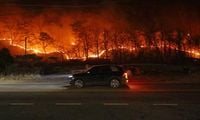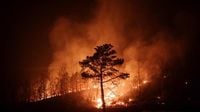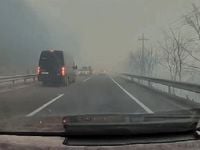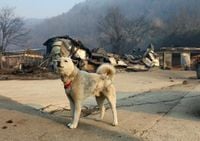South Korea is grappling with a catastrophic wildfire crisis, as devastating blazes sweep through its southeastern regions, claiming at least 24 lives and forcing over 27,000 residents to evacuate. The fires, which erupted on March 19, 2025, have scorched more than 36,000 acres, with the largest inferno—burning over 31,000 acres near populated areas—only 68% contained as of March 26, 2025, according to reports from The Washington Post.
The wildfires have spread with alarming speed, with the Uiseong fire now ranking as the third-largest in South Korea’s history, having consumed approximately 10,000 hectares, as reported by The Korea Herald. Another major blaze in Sancheong County has burned 1,500 hectares, while smaller fires in Ulsan and surrounding areas have been contained or extinguished, though the overall situation remains volatile.
The death toll stands at 24, including three firefighters and one government official, with additional casualties discovered in Uiseong and Sancheong counties, according to Reuters. The rapid progression of the fires and the challenging conditions have left authorities scrambling to protect lives and property. In response, the South Korean government has designated North and South Gyeongsang provinces and Ulsan as disaster zones, unlocking emergency resources to tackle the crisis.
Nearly 9,000 personnel—including firefighters, police, and civil servants—are battling the flames, supported by 128 helicopters, as detailed in The Washington Post. The military has also stepped in, deploying 5,000 troops and 146 helicopters, halting all exercises to focus on firefighting efforts. Prime Minister Han Duck-soo emphasized the severity, stating, “We are confronting the worst wildfires in our history using all available personnel and equipment, but the situation remains dire,” highlighting the urgency of the situation.
Evacuations are widespread, displacing over 27,000 people across multiple counties. In Uiseong and Andong alone, 20,313 residents have fled, while 5,000 from Ulju town and 260 from Sancheong County have been relocated to temporary shelters. The Ministry of Justice has taken the extraordinary step of transferring about 500 inmates from a major prison complex in North Gyeongsang Province, as the fires encroach, a move reported by Reuters.
The scale of displacement underscores the crisis’s devastating reach. Personal stories highlight the human toll. Lee Ji-hyun, an evacuee from Andong, told CNN, “The sky was black with smoke, and the heat was unbearable. We had to leave everything behind,” painting a vivid picture of the chaos. The wildfires are fueled by a deadly combination of strong winds reaching 45 mph, dry conditions, and unseasonably high temperatures. Climate change has worsened the situation, with temperatures 4.5°C to 10°C above average, creating a tinderbox, as noted by Climate Central.
The fires’ origins are varied, with the Sancheong blaze sparked by a lawn mower and the Uiseong fire linked to a grave site, according to The New York Times. These seemingly mundane triggers have spiraled into a national emergency. Beyond the loss of life and homes, the wildfires have dealt a cultural blow. The Gounsa Temple in Uiseong, a Buddhist site over a thousand years old, has been destroyed, a loss of heritage mourned deeply, as reported by The New York Times.
Firefighting efforts are being hampered by mountainous terrain and thick smoke, which restrict helicopter access. The Uiseong fire’s containment rate has dropped, with its fire line expanding from 164 km to 214.5 km, a troubling development noted by The Korea Herald. Weather forecasts offer little relief, predicting minimal rain and sustained dry conditions. Authorities are bracing for a prolonged fight, with the situation showing no immediate signs of abating.
The economic fallout is expected to be immense. Past wildfires in 2000 and 2022 caused $32 million and $750 million in damage, respectively, offering a grim precedent for the current crisis, as per The Washington Post. The long-term impact on local communities, agriculture, and tourism remains unclear, but the immediate focus is on containment and ensuring resident safety. The fires threaten to reshape the region’s economic landscape for years to come.
Internationally, the crisis has drawn concern, with offers of assistance from neighboring countries and global organizations. For now, South Korea’s well-equipped emergency services are managing the response, but the scale of the disaster may yet prompt broader support. The resilience of South Korea’s people is being tested as never before. Families are separated, communities uprooted, and historical treasures lost, all amid a relentless natural assault.
As firefighting efforts continue around the clock, the nation holds its breath, hoping for a break in the conditions or a surge in containment success. The world watches, united in concern for a country facing an unprecedented ordeal. As the fires continue to rage, the government and humanitarian organizations are mobilizing resources to assist those affected by this disaster.








